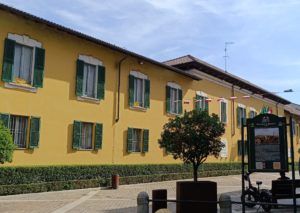Piazza Formenti
Il campo italiano durante la Battaglia di Magenta

La Battaglia del 4 giugno 1859 fu uno degli eventi determinanti della II Guerra d’Indipendenza.
Il comando dell’Armata Franco-Sarda fu assunto da Napoleone III, mentre l’Imperial Regio Esercito Austroungarico rispondeva agli ordini del Maresciallo Conte Gyulay.
Dopo le battaglie di Montebello e Palestro gli Austriaci arretrarono e stabilirono una linea difensiva tra Ticino e Naviglio Grande.
Il 2 e 3 giugno i Francesi passarono il fiume a Turbigo sostenendo i primi scontri.
La mattina del 4 attraversarono anche il ponte napoleonico sul Ticino che aveva resistito alle mine e si mossero verso i ponti sul Naviglio Grande.
Fatti saltare quelli di Boffalora e Ponte Vecchio, dopo accaniti combattimenti dall’esito incerto, i francesi riuscirono a passare sul Ponte Nuovo e su quello della ferrovia solo quando gli Austriaci, minacciati sul fianco destro da Mac Mahon, si ritirarono attestandosi a Magenta.
Verso sera l’impeto degli Zuavi e della Legione Straniera travolse gli Austriaci che si erano attestati nel cimitero, nella vecchia parrocchiale di San Martino, lungo la ferrovia e in Casa Giacobbe.
Sul fianco sinistro alleato presero posizione i Bersaglieri e l’artiglieria piemontese mentre i reparti asburgici abbandonavano Magenta.
Le porte di Milano erano aperte.
L’8 giugno Napoleone III e Vittorio Emanuele II sfilarono vincitori sotto l’Arco della Pace, al Sempione.
Français
La bataille du 4 juin 1859 fut l’un des événements les plus décisifs de la Deuxième Guerre d’Indépendance.
C’est Napoléon III qui commandait l’armée franco-sarde, tandis que l’armée impériale austro-hongroise obéissait aux ordres du maréchal, comte Gyulay. Après les batailles de Montebello et Palestro, les Autrichiens se retirèrent et établirent une ligne défensive entre le Tessin et Naviglio Grande. Le 2 et 3 juin, les Français passèrent le fleuve à Turbigo, en soutenant les premières attaques. Le matin du 4, ils traversèrent également le pont napoléonien sur le Tessin, qui avait résisté aux charges explosives, et avancèrent en direction des ponts sur le Naviglio Grande.
Ceux de Boffalora et du Ponte Vecchio furent faits sauter. Ce n’est qu’après de combats acharnés au résultat incertain que les Français réussirent à franchir le Ponte Nuovo et le pont ferroviaire, lorsque les Autrichiens, menacés sur leur flanc droit par Mac Mahon, se replièrent pour se retrancher à Magenta.
Vers le soir, l’élan des Zouaves et de la Légion étrangère accabla les Autrichiens, qui s’étaient retranchés dans le cimetière, dans l’ancienne église paroissiale de San Martino, le long de la ligne de chemin de fer et dans la Casa Giacobbe. Sur le flanc gauche allié, les Bersaglieri et l’artillerie piémontaise prirent position tandis que les unités des Habsbourg abandonnaient Magenta.
Les portes de Milan étaient ouvertes. Le 8 juin, Napoléon III et Vittorio Emanuele II défilèrent en vainqueurs sous l’Arche de la Paix, au Sempione.
Deutsch
Die Schlacht vom 4. Juni 1859 war eines der entscheidenden Ereignisse des Zweiten Unabhängigkeitskrieges.
Das Kommando über die französisch-sardische Armee wurde von Napoleon III. übernommen, während die kaiserlich-königliche österreichisch-ungarische Armee den Befehlen von Marschall Graf Gyulaj folgte.
Nach den Schlachten von Montebello und Palestro zogen sich die Österreicher zurück und errichteten eine Verteidigungslinie zwischen dem Tessin und dem Naviglio Grande.
Am 2. und 3. Juni überquerten die Franzosen den Fluss in Turbigo und erlitten die ersten Verluste.
Am Morgen des 4. überquerten sie auch die napoleonische Brücke über den Tessin, die den Minen widerstanden hatte, und zogen in Richtung der Brücken über den Naviglio Grande.
Nachdem die Brücken von Boffalora und Ponte Vecchio gesprengt worden waren, gelang es den Franzosen nach heftigen Kämpfen mit ungewissem Ausgang, die Brücke Ponte Nuovo und die Eisenbahnbrücke zu überqueren, nachdem die Österreicher, die auf der rechten Seite von Mac Mahon bedroht worden waren, sich nach Magenta zurückgezogen hatten.
Am Abend überwältigte der Ansturm der Zuaven und der Fremdenlegion die Österreicher, die sich auf dem Friedhof, in der alten Pfarrkirche San Martino, entlang der Eisenbahn und im Haus Giacobbe verschanzt hatten.
Auf der linken Seite der Alliierten nahmen die Scharfschützen und die piemontesische Artillerie Stellung, während die habsburgischen Truppen Magenta verließen.
Die Tore von Mailand waren offen.
Am 8. Juni zogen Napoleon III. und Viktor Emanuel II. als Sieger unter dem Friedensbogen am Sempione hindurch.
English
The Battle of 4 June 1859 was one of the decisive events of the Second Italian War of Independence.
The command of the Franco-Sardinian Army was held by Napoleon III, while the Imperial Royal Austro-Hungarian Army answered to Marshal Count Gyulaj.
After the battles of Montebello and Palestro, the Austrians retreated and established a defensive line between the Ticino River and the Naviglio Grande canal.
On 2 and 3 June, the French crossed the river at Turbigo, sustaining the first skirmishes.
On the morning of the 4th, they also crossed the Napoleonic bridge over the Ticino, which had withstood mines, and moved towards the bridges over the Naviglio Grande.
After blowing up the bridges at Boffalora and Ponte Vecchio, after fierce fighting with an uncertain outcome, the French managed to cross the Ponte Nuovo and the railway bridge only when the Austrians, threatened on the right flank by Mac Mahon, withdrew and took position at Magenta.
Towards evening, the momentum of the Zouaves and the Foreign Legion overwhelmed the Austrians, who had entrenched themselves in the cemetery, the old parish church of San Martino, along the railway, and in Casa Giacobbe.
On the left flank, the Bersaglieri and Piedmontese artillery took position while the Habsburg troops abandoned Magenta.
The gates of Milan were open.
On 8 June, Napoleon III and Victor Emmanuel II marched triumphantly under the Arch of Peace, at the Sempione.
Ultimo aggiornamento: 03/06/2025, 09:52